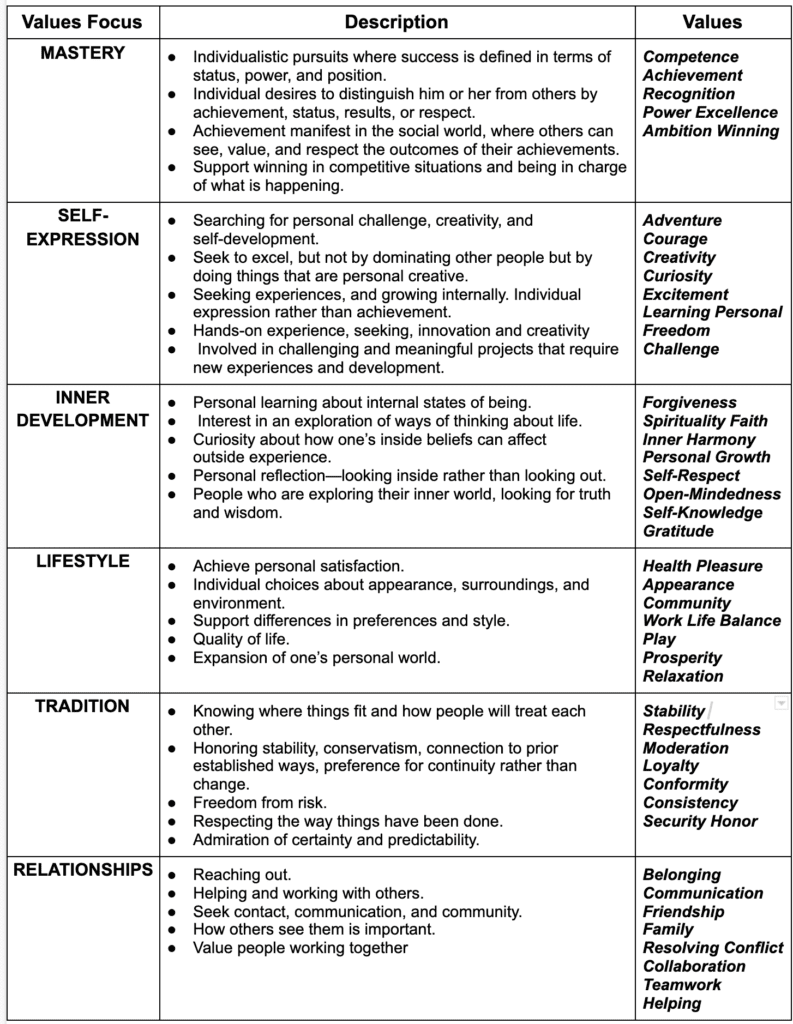The Values Wheel helps people consciously organize their lives and actions by defining “clusters” of values. Each one refers to a set of values that reflect a particular theme. They express seven different ways that people orient to their environment and make choices about time, tasks, and using their energy.
None of these areas are better or worse than the others; they are just different. The Values Wheel helps you see how what you believe leads you to approach tasks, relationships, and work. Just as actions shape your values, so having a family, group, workplace, or community dialogue about them can make it more conscious and aligned with your actions.
Intrinsic Values: The Center
The center of the wheel contains core values that people consider good in themselves. These global values support the sustainability and future of human society and express the most important elements of human culture.
Values pioneer, Milton Rokeach, called these intrinsic values because they are central to a person’s’ fundamental beliefs. Some people consider these so basic and “baked in” that they do not choose or express them when they identify their core values. They represent what has unquestioned importance to us—they are the core of who we are. It is hard for us to live if we do not practice this value; we cannot live comfortably with the opposite.
The surrounding wheel defines six styles of action by which people actualize their intrinsic values and other activities that they consider important. They include:
- Integrity
- Tolerance
- Peace
- Social Responsibility
- Sustainability
- Fairness
- Beauty
- Trust
We have found that people can actively hold between three to five such intrinsic values that express what they consider most important about living. They are often made public in a family or company values statement as things everyone is expected to share and live by. They are easy for people to agree with.
The challenge is for people to actually make their actions fit these ideals, and to keep these values in focus, especially in times of stress. We have seen people who believe in tolerance exclude others who disagree with them and people who value trust act in dishonest ways. Typically, they are never fully achieved and often held as aspirations to work toward.
The Wheel: Six Values Styles
Primary, Secondary, and “Shadow” Styles
People usually have one major focus, one point of the values wheel which contains more of their values. This is their primary style. Many people have not just one but a second style that is almost equally important. This is their secondary style.
Looking at your key values you can select a major and minor style by seeing which point of the Values Wheel reflects more of who you are. For example, in a pyramid of 15, four may lie within the self-expression focus area. The other 11 values will be intrinsic or are distributed within other categories. Maybe you find that three lie in the relationships category, and that will be your secondary style.
People with a certain primary style may find themselves in disagreement or even conflict with people who have different styles. Looking at the Values Wheel, there are three pairs of orientations that are at opposite sides:
- Mastery and Lifestyle
- Self- Expression and Tradition
- Inner Development and Relationships
The opposite point of your primary style on the wheel is known as your “shadow” style. This is a style that is very different than your own, and you may find that the opposites are ones that you are suspicious of. You may find it hard to understand why a person would hold your shadow values or even find yourself in conflict with them.
For example, a creative person with a primary value on self-expression may find it hard to understand and accept a person who values tradition and the status quo, or an achievement-oriented mastery style will find it difficult to accept a person who puts the highest priority on their personal and family life.
Some members of your family or team will have styles that are the shadows of other people. By seeing them as values differences they can learn to understand each other even if they don’t agree with each other’s choices and focus. They can get beyond conflict and learn to respect and understand differences without argument about whose values are better or right. This person also helps us view shadow values as parts of ourselves and activities that we may have overlooked in our lives. A mastery-oriented person who is always striving at work may have something to learn from a person who values family or pleasure.
After we list our values we are tempted to say that we are done. Check back next week to discover the next step in this exercise.
This is the second in a series about values. You can find the first here. Check back for more information in the coming weeks. Reprinted with permission.
Become a Member for Your Expertly Curated Advice
Joining the Family Wealth Library means access to the information the legacy builders need to navigate family dynamics and protect our wealth. We can keep what is ours by managing familial challenges and building trust and transparency.

